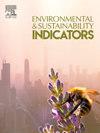分散式水管理的物质流动和资源潜力分析:奥地利生态村的现场水和养分再利用及其向城市环境的升级
IF 5.4
Q1 ENVIRONMENTAL SCIENCES
引用次数: 0
摘要
城市缺水和不断增长的农业用水需求突出表明迫切需要在水和养分管理方面采取先进、可持续的战略。本研究考察了绿色墙处理系统在现场水和养分再利用方面的潜力,以创建当地的循环食品系统。评估了两个案例研究:Cambium生态村(奥地利施提里亚州农村地区)和Zukunftshof城市农场(奥地利维也纳市),其中涉及绿色墙处理系统以及雨水和堆肥的使用。采用物质流分析方法来研究这些方案在满足农业用水和养分需求方面的效率。研究结果表明,这些废水处理和再利用系统可以整合到不同的社区项目中,表明它们在特定地点之外具有更广泛的适用性。可完全覆盖当地磷肥需求,以及相当比例的氮肥需求(高达90%的需求覆盖率)。在Cambium,绿墙系统的再生水几乎可以满足所有的水需求,通过仅利用20%的可用废水实现高达90%的覆盖率,其限制是防止因再生水中高营养成分而过度施肥。对于较大的区域,建议将其与雨水收集相结合,以充分解决水需求。与雨水收集作为水源和堆肥作为营养来源相比,再生废水具有优势,因为它具有一致的可用性和减少的储存要求。整合厌氧消化进一步提高营养物质的回收和支持可持续能源的产生。总体而言,绿墙处理系统可以有效地关闭当地的水和养分循环,增强当地粮食生产的复原力和可持续性。本文章由计算机程序翻译,如有差异,请以英文原文为准。
Analysis of material flows and resource potential of decentralized water management: On-site water and nutrient reuse in an Austrian eco-village and its upscaling to urban environments
Urban water scarcity and growing agricultural water demands underscore the urgent need for advanced, sustainable strategies in water and nutrient management. This study examines the potential of green wall treatment systems for on-site water and nutrient reuse to create local circular food systems. Two case studies are evaluated: Cambium eco-village (rural area of Styria, Austria) and Zukunftshof urban farm (city of Vienna, Austria), with scenarios involving green wall treatment systems as well as rainwater and compost use. A material flow analysis approach is used to investigate the efficiency of these scenarios in meeting agricultural water and nutrient demands.
The findings show that these wastewater treatment and reuse systems can be integrated in different community projects, demonstrating their broader applicability beyond site-specific contexts. Local phosphorus fertilizer demand can be fully covered, as well as a considerable proportion of the nitrogen fertilizer demand (up to 90 % demand coverage rate). At Cambium, the reclaimed water of the green wall system can nearly supply all water demands, achieving up to 90 % coverage by utilizing only 20 % of the available wastewater, with the limitation being to prevent overfertilization due to the high nutrient content in reclaimed water. For larger areas, combining it with rainwater harvesting is recommended to fully address water needs. Reclaimed wastewater offers advantages over rainwater collection as source of water and composting as source of nutrients due to consistent availability and reduced storage requirements. Integrating anaerobic digestion further enhances nutrient recovery and supports sustainable energy generation. Overall, green wall treatment systems can effectively close local water and nutrient cycles, enhancing resilience and sustainability in local food production.
求助全文
通过发布文献求助,成功后即可免费获取论文全文。
去求助
来源期刊

Environmental and Sustainability Indicators
Environmental Science-Environmental Science (miscellaneous)
CiteScore
7.80
自引率
2.30%
发文量
49
审稿时长
57 days
 求助内容:
求助内容: 应助结果提醒方式:
应助结果提醒方式:


